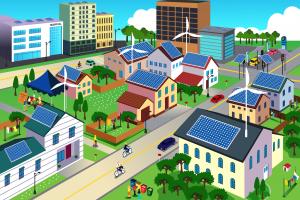- 457 reads

Tips For Living a Green Life in Your Home
Do you know how to go green in your home? Do you want to? We live in a dynamic environment. Pollution is increasing, global temperatures are rising, and resources keep declining. It’s now evident we need to embrace a greener and sustainable approach towards our lives.
The more we go green, the much money we will save on our part. Surprisingly, going green is much more comfortable, and there are many ways through which you can create a green living space.
Now you can use these simple concepts to change your home from a carbon-producing station into a conservatory like home. All it takes is to implement simple energy saving ideas to create a more sustainable home for your family.
Start by appreciating the many benefits of energy efficiency, use environmentally friendly products such as Eco-smart water heaters instead of hazardous products among others.
Building a green home for your family can be quite rewarding. You get a chance to empower your family members on the benefits of living an Eco-friendly lifestyle.
Also, you get to engage in a clean environment far from pollution. While it’s easier to live green and save money, the initial renovation expenses can be moderately expensive. If you are building a green home from scratch you will find the same thing.
Consequently, you will need to plan ahead with your financing to turn your green home dream into a reality. Here is what the lender will need to get your mortgage approved. You will see a detailed overview of the documents required for the most popular types of loans.

Benefits of Going Green
Having a prolific green home means the ability to cut expenses when necessary. It entails reducing electricity costs as well as products which harms our ecosystems.
Even though there are many ways to go green without blowing your budget, a number of them are mostly overlooked. Below are the top reasons why you need to embrace a green home
- You will forget the anxiety associated with huge monthly bills.
- You'll save extra cash for other things such as vacations or doing things with the kids.
- Empowering other family members to embrace energy efficiency when performing different tasks. For instance, they should use electricity only during off-peak hours when energy rates are low.
- You really can make good use of your savings on anything of your choice.
Below are the top 15 green home building tips
Ask the builder about construction methods
Building a green home is a lot different than standard new construction. The building technique will be a lot different. There will be far fewer builders to choose from when it comes to building a green home. None the less it is important to do your due diligence by asking the builder questions about construction and their procedures. Learn as much as you can about the builder and their reputation.
Select a good location
There are a lot of things you should consider before purchasing a property - the location is certainly one of them. You should always consider the positioning of the sun throughout the day when building an green home.
In addition, avoid building a home in a hazardous place such as flood areas, hurricane, and earthquake zones. To minimize the costs of traveling to shopping centers and restaurants, consider a home located close to these amenities.
Use solar panels
One of the best ways to reduce energy costs, and consumption is to install a solar panel system on your home. It is one of the smartest innovations that uses power from the sun to supply energy. Solar energy is one of the cleanest and renewable sources of energy. Make sure to install the solar panel in an ideal location to collect large quantities of power.
Here is what you need to know about buying a home with solar power. Keep in mind that while the goal is saving energy, money and the environment you don't want to make a mistake with the installation of your solar panels.
For example, if you are building an expensive home it may be a big mistake to put a less than attractive solar panel system on the front of your property. While being energy conscious is great, you don't want to damage what could be your most prized long term investment.
Small houses are better
A lot of individuals have a fascination with building or purchasing large homes. For many a large home is their trophy statement to the world that they have made it. Going green involves a much different thought process.
Huge McMansions have a tremendous impact on the environment due to the large expenditures of heating and cooling. Constructing a small house with eco-friendly methods will as well help reduce this effect. A smaller green home will have a much different effect on the environment.
Buy energy efficient appliances
When buying house equipment and appliances you should choose ones that have an energy star label certified by the Environment protection agency. These appliances reduce energy costs and help you save money without compromising their performance.
While the initial cost may be a little more, it will be well worth the cost savings over time.
Prevent air leaks by insulating the house
Having extra insulation is one of the best means of bringing down a homes energy costs. A property with air penetration around windows, doors, and duct work leads t0 heat loss, high energy consumption, and an increase in costs to heat and cool.
To prevent this from happening, maximize the insulation in your green home to control the heating and cooling expenses. Putting extra insulation in your home certainly can't hurt. If you live in a cold weather climate having extra insulation may offer an additional side benefit of preventing ice dams from happening.
Use a programmable thermostat
One of the easiest ways to reduce the costs and cut down electricity bills is to install a programmable thermostat on your heating and cooling systems. By programming the system around your lifestyle you can save additional money.
For example, if you work nine to five you may want to have the heat or cooling set differently than when you are around. By adjusting your thermostat to something higher or lower depending on the season when you are not home could save hundreds of dollars.
Employ geothermal energy
Thought it requires a significant initial investment to extract geothermal energy, this energy source is one of the most efficient and unlimited methods to heat and cool your house. Just be prepared to spend a lot more money installing the system up front. This is one of those expenditures where you will need to stay around in the home for a while to recapture your investment.
The geothermal pump utilizes the earth loop to extracts heat from deep underground to your home HVAC system during the winter, while in the summer, heat is moved back into the earth through looping system after being extracted from the air.
Choose to reuse and recycle home products
Reduce the need to buy new products that are not environmentally friendly. When building a new house if you happen to have old materials like wood floors, doors, and you might be able to use some of these items. Materials such as glass, aluminum, tiles, wood or plastic can be used again in the construction of a green home through recycling.
Use Eco-friendly construction materials
When you have a dream of building a green home, the materials you will use for the building, roofing, cabinets, and counters need to be Eco-friendly. Don’t forget to insulate the floor cabinets with environmentally friendly materials.
Natural products for instance; bamboo, cork, and linoleum are the best renewable products to use. Extra materials include reclaimed lumber and recycled glass.
Buy energy star labeled windows
When deciding on the kind of window to use on your green home, go for the Energy Star labeled windows. They have a better rating which makes them more energy efficient and cost-effective than standard windows.
Proper ways to harvest rainwater
Rain is one of the top sources of water when building a green home; you have to employ mechanisms to collect rainwater; for instance, rain barrels is one of the recent methods to use. The collected water can be used for toilet purposes and on sprinkler systems.
Here is an excellent resource for learning how to harvest rain water. Use this terrific resources as your guide.
Use a tank-less water heater
When you want to heat water that is only required for a specific need, use tank-less water heaters, these heaters have an electric coil that only heats water that is needed as it passes through the loop. The tank-less water heater system is one of the best as it reduces energy expenses, water wastage, and gives you enough storage space as you don’t have to use the hot water tank.
There are also energy star rated water heaters as well.
Eco-friendly water apparatus
Buy apparatus that conserve and cut water costs in your green home, use shower-heads and low flow faucets to conserve water and make your house Eco-friendlier environment. For cleaning, purposes use apparatus for instance dishwashers and washing machines to help you save water and energy.
Use an energy efficient lighting system
When you want to light your green home, buy lights that use less energy and can last long, for example, Led and CFL lights. They are Eco-friendly, and expensive but can help you save cash in the long run than the traditional incandescent bulbs.
An appealing Eco-friendly landscape
Planting plenty of trees around your home will provide more shade that will help protect your house from direct exposure to the sun during the summer and allow more sunlight to reach in during the winter. During the summer the trees protect your home from direct sunlight and keep the house cooler while during the winter the trees shade leaves, thus allowing more sunlight into the house.
Get an energy audit
After you have done all of these green improvements to your house, it makes sense to get a home energy audit done. By having your homes energy consumption looked at you can determine if there are any weak areas and improve upon them.
In many states you can get some significant rebates on products they will offer such as additional insulation, light bulbs, etc. Quite often the energy audit company will also seal any areas of your home where there are drafts occurring. An energy audit is well worth the money!
Ways to turn your house green
For one to entirely turn green, he/she has to choose various methods and techniques that are simple and often ignored by people. Below are some of these methods:
1. Switch off lights or any appliance when not in use
2. Use products and items that are recyclable and reusable for instance containers and plastics
3. Unplug devices such as mobile and laptop chargers when not in use.
4. During entertainment time, employ safe and Eco-friendly techniques.
5. Teach your family members to adapt and use a family energy plan daily.
Final thoughts
Hopefully, you have enjoyed these tips on going green with a new home. You may want to consider incorporating these going green tips as part of your annual spring home maintenance. You can make some of these green home improvement upgrades easily at the time of your ongoing maintenance schedule.
Did you enjoy these tips? See ten more ways to go green in your home. Best of luck in your quest to be more Eco-friendly!

